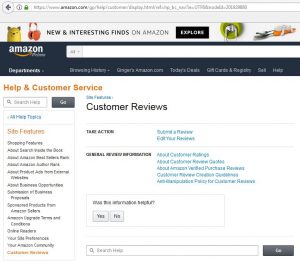There’s a lot of question around Amazon reviews. As a publisher/author this is a subject near and dear to my heart. So, I went searching and found the answers. Now, to set the record straight, it seems going to the source directly, instead of reading other ‘take’ on the issue makes the most sense.

When I first arrived at the Official Help Page for Customer Reviews it was a bit confusing as I found that when I click each link in the body of the page it came up blank. Nevertheless, my tenacity paid off when I discovered that on the left sidebar is a list of subtopics that actually hold the information I was on my Amazon Quest to find. Oh, I like that!
So, here we go …
Rule 1: You must be a customer WITH an active, purchase profile.
Before you can post a review, you need to have an Amazon.com account that has successfully been charged for the purchase of a physical or digital item. Free digital downloads don’t qualify.
Now that is good news.
However, there’s a 48-hour waiting period after your first physical order has been completely shipped, or your digital item has been purchased, before you’ll be able to submit your review. If you’ve purchased a digital gift for someone else, the 48-hour waiting period doesn’t begin until the gift has been redeemed.
This requirement helps to ensure fake accounts can’t post reviews for products or write negative reviews on their competitor’s products. Which brings us to Rule 2.
Rule 2: Zero Tolerance
Customer Reviews are meant to give customers genuine product feedback from fellow shoppers. Their goal is to “capture all the energy and enthusiasm (both favorable and critical) that customers have about a product while avoiding use of reviews to outright advertise, promote and especially mislead.” They have a zero tolerance policy for any review designed to mislead or manipulate customers.
Authors and artists can add a unique perspective and they very much welcome customer reviews. While they encourage reviewers to share their enthusiasm and experience, there can be a fine line between that and the use of customer reviews as product promotion. They don’t allow anyone to write customer reviews as a form of promotion and if they find evidence that a customer was paid for a review, they’ll remove it.
“If you have a direct or indirect financial interest in a product, or are perceived to have a close personal relationship with its author or artist, we’ll likely remove your review.”
Nor do they allow authors to submit customer reviews on their own books even when they disclose their identity. Now that does make sense!
To help illustrate, here are a few examples of reviews that they don’t allow:
- A product manufacturer posts a review of their own product, posing as an unbiased shopper
- A shopper, unhappy with her purchase, posts multiple negative reviews for the same product
- A customer posts a review in exchange for $5
- A customer posts a review of a game, in exchange for bonus in-game credits
- A family member of the product creator posts a five-star customer review to help boost sales
- A shopper posts a review of the product, after being promised a refund in exchange
- A seller posts negative reviews on his competitor’s product
- An artist posts a positive review on a peer’s album in exchange for receiving a positive review from them
There is an appeals process if you think they got it wrong and removed a customer review that shouldn’t have been removed, even it it is your own. It starts with a simple e-mail to review-appeals@amazon.com.
Note: The best place for authors (or publishers) to communicate with their readers is in the Book description, Editorial Reviews and From the Author sections. To learn more about taking advantage of these features, visit Author Central.
Rule 3: Anti-Manipulation Policy
If Amazon thinks you’re attempting to manipulate reviews or violate their guidelines in any manner, they may immediately suspend or terminate your Amazon privileges, remove reviews, and delist related products.
In addition, if they determine that an Amazon account has been used to engage in review manipulation, remittances and payments may be withheld or forfeited. Misconduct may also violate state and federal laws, including the Federal Trade Commission Act, and can lead to legal action and civil and criminal penalties. So tread lightly here.
Amazon Author Articles
This is something I didn’t know, and you may not have been aware of either. You can actually be invited by Amazon to write articles from your experience about your product experience. These articles will appear on your profile page. However, Amazon may “use the article in other ways to help provide a great shopping experience.”
And lastly …
Amazon Verified Purchase
An “Amazon Verified Purchase” review simply means Amazon has verified that the person writing the review purchased the product at Amazon and didn’t receive the product either free or for a deep discount. Reviews that are not marked “Amazon Verified Purchase” are still considered valuable. Which tells me for certain you don’t have to have purchased the product to leave your Amazon Customer Review. It simply meant that they can’t confirm that the product was purchased at Amazon or the customer did not pay the price listed on Amazon.
To read the rules yourself, you too can visit: https://www.amazon.com/gp/help/customer/display.html/ref=hp_bc_nav?ie=UTF8&nodeId=201929880
